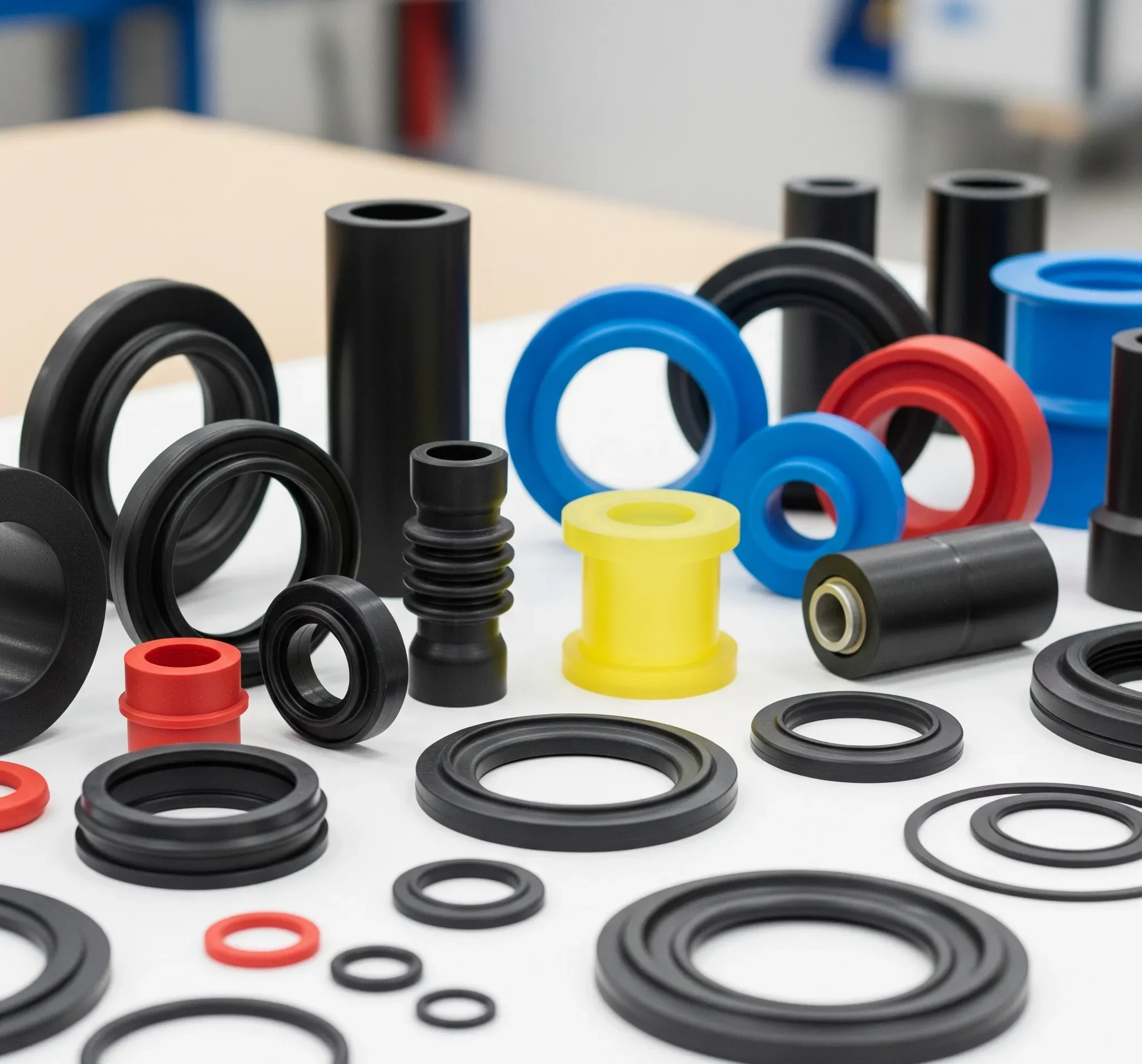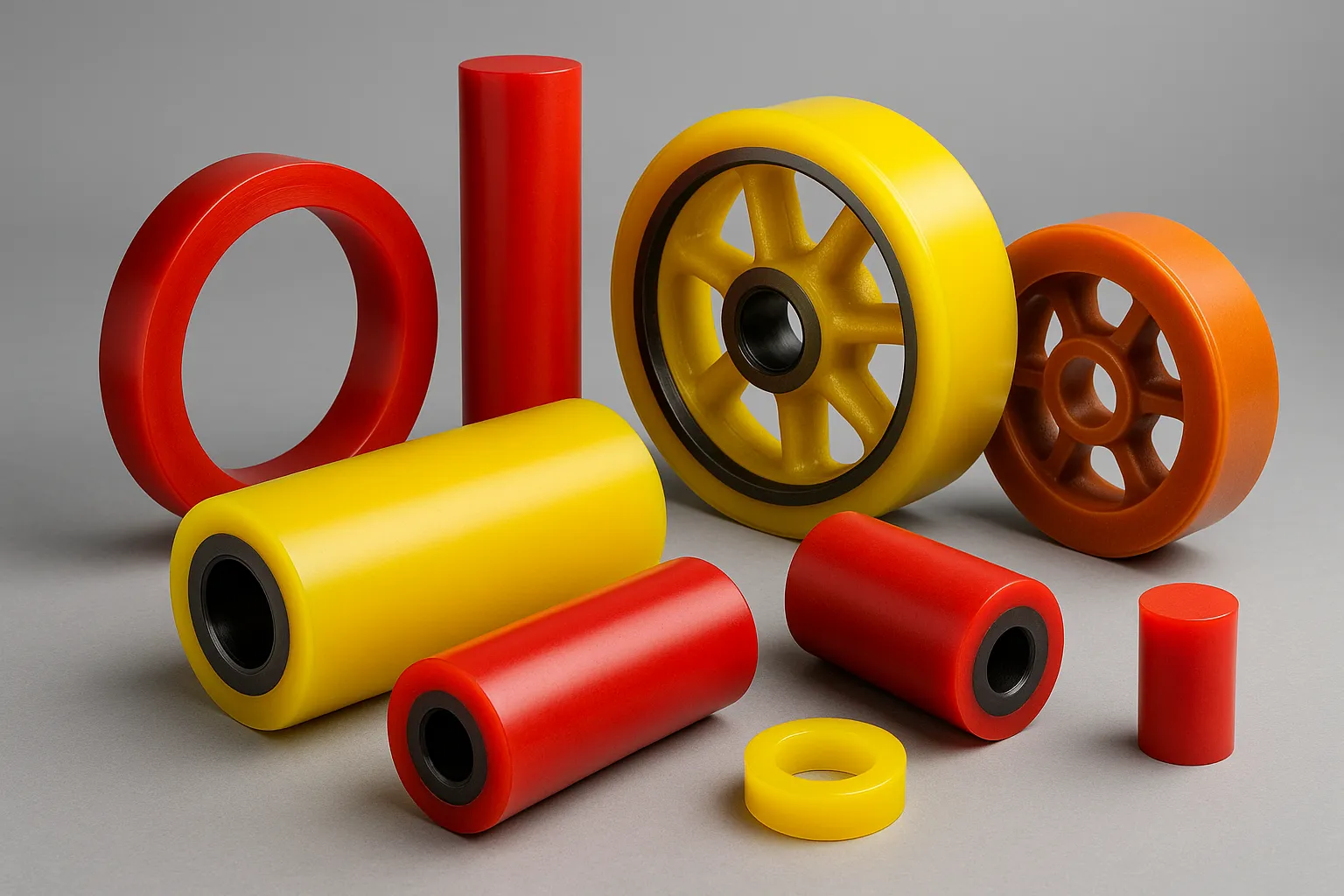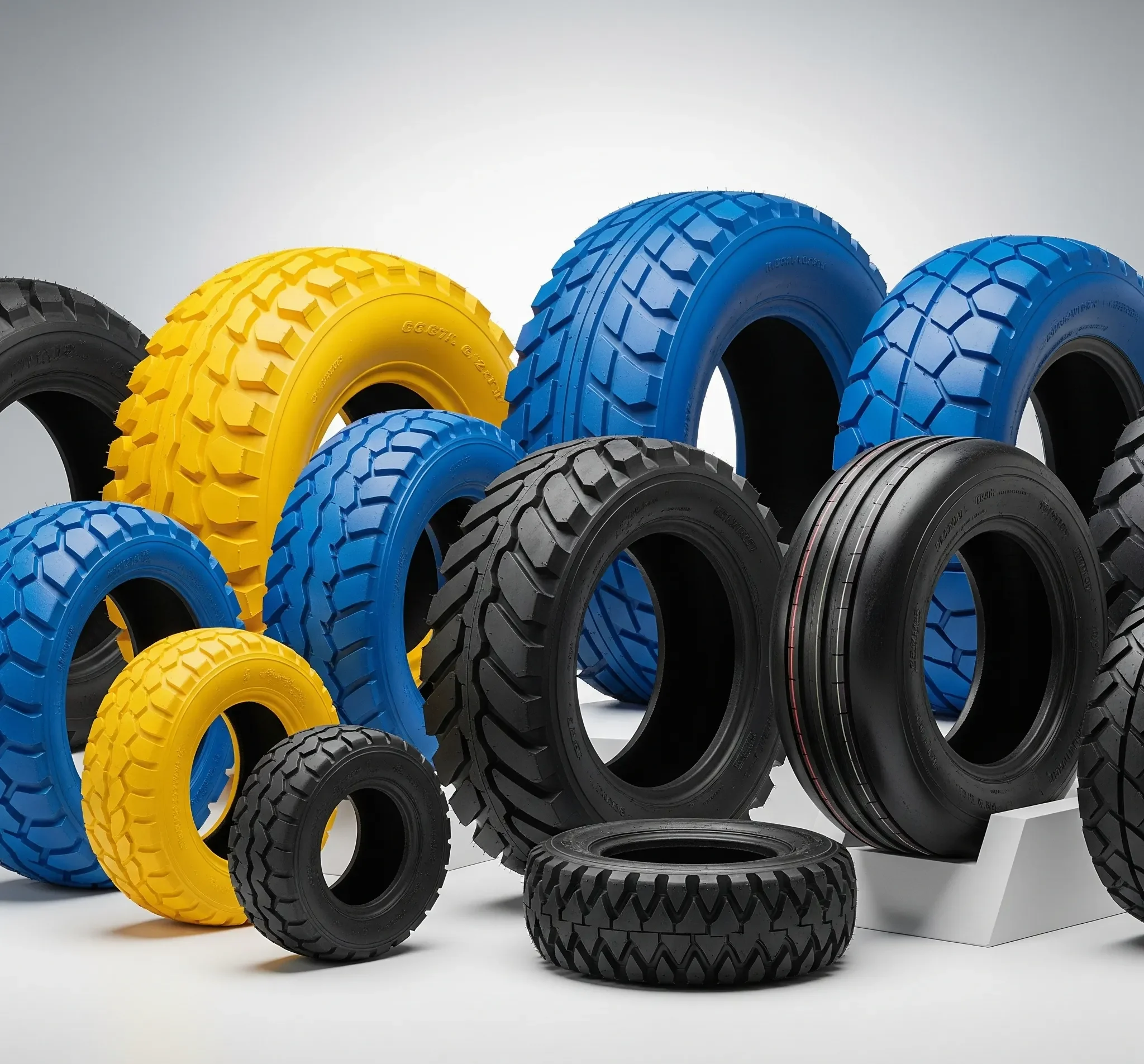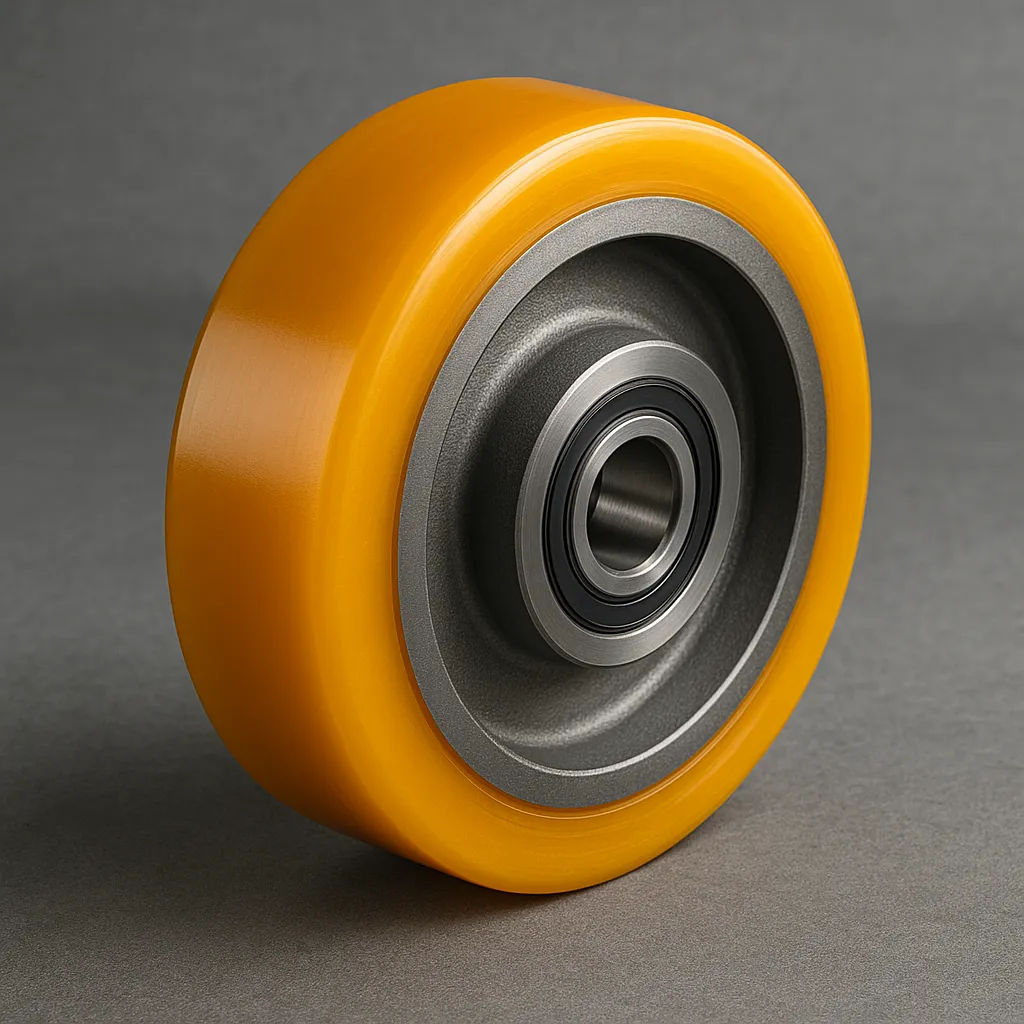Polyurethane rubber in Iran
جهت خرید انواع لاستیک،لاستیک پلی اورتان،لاستیک صنعتی، با لاستیک سازی پایا پیو در ارتباط باشید.
جهت سفارش تولید انواع لاستیک صنعتی، با ما در تماس باشید.

تولید انواع پلی اورتان در اصفهان با استانداردهای روز و کیفیت تضمین شده در بازار

To order the purchase of Polyurethane rubber in Iran, to purchase polyurethane parts, and to purchase hydrocyclone, please contact Naqsh Jahan’s stable polymer

تولید لاستیک صنعتی در شرکت پایدار پلیمر نقش جهان
Buying polyurethane parts from Iran

آشنایی با پلی اورتان
جهت خرید Polyurethane rubber و لاستیک صنعتی و rubber industry با ما مشورت کنید.
Buying Polyurethane rubber in Iran

جهت سفارش و خرید انواع لاستیکبا لاستیک سازی پایدار پلیمر نقش جهان در ارتباط باشید.
Buying parts and Polyurethane rubber in Iran
برای مشاوره و خرید هیدروسیکلون ، پلی اورتان ، Hydrocyclone،Industrial rubber همین الان تماس بگیرید.
Manufacturing stages of anti-wear polyurethane parts and rubber in Isfahan, Iran
جهت خرید (المطاط الصناعي) با ما در تماس باشید
The steps for manufacturing and producing polyurethane rubber in Iran are as follows:
Preparation of raw materials
The first step in making polyurethane rubber in iran is to prepare the raw materials. The raw materials required for the production of rubber are:
Polyol: Polyol is an organic polymer formed by the reaction of glycols with diisocyanates. There are different types of polyols, each with different physical and mechanical properties.
Diisocyanate: Diisocyanate is an organic polymer made from two isocyanate groups. There are also different types of diisocyanates, each with different physical and mechanical properties.
Catalyst: A catalyst is a chemical substance that increases the rate of the reaction step between polyol and diisocyanate.
Mixing the raw materials
After preparing the raw materials, the materials must be mixed in the correct ratio. The ratio of polyol to diisocyanate is usually 1:2. The catalyst must also be added to the mixing container in small amounts.
Casting or extrusion
The mixture of polyol, diisocyanate and catalyst is then transferred to a mold or extrusion machine. In molding, the mixture is poured into a mold and removed from the mold after it hardens. In extrusion, the mixture is fed through a nozzle into the desired shape. Production of anti-wear and anti-static Polyurethane rubber in Iran
Cooking
After casting or extrusion, rubber must be cured at high temperatures to give it physical and mechanical properties. Curing times and temperatures vary depending on the type of polyurethane.
Cutting and finishing
After the curing stage, the rubber must be cut into desired sizes and shapes. The surface of the rubber may need to be polished.
The production and manufacturing steps ofPolyurethane rubber in Iran are generally carried out in two ways:
Casting
In the casting method, a mixture of polyol, diisocyanate, and catalyst is poured into a special mold and removed from the mold after it hardens. This method is suitable for producing and manufacturing rubber parts with complex, precise, and calculated shapes.
Extrusion
In the extrusion method, a mixture of polyol, diisocyanate, and catalyst is forced through a nozzle into the desired shape. This method is suitable for producing rubber parts with simple and uniform shapes.
Polyurethane rubber in Iran has a wide range of applications in various industries. It can be used in the production of automotive parts, furniture, flooring, medical and sports equipment, and other products.
برای خرید هیدروسیکلون ، پلی اورتان ، Hydrocyclone،Industrial rubber با ما در تماس باشید.
History of polyurethane
Polyurethane rubber in Iran was first discovered by Otto Bayer in Germany in 1937. Since then, this material has made significant progress in various industries around the world with its unique properties. The production of polyurethane anti-wear rubber in Isfahan, Iran marked the first production of polyurethane through a reaction process. Polyurethanes are compounds that have urethane bonds in their structure. Polyurethane (PU) is a general term used for polymers that have urethane bonds.
The production of polyurethane anti-wear and anti-electricity rubber has been a significant achievement. The urethane bond is formed through an addition reaction between an isocyanate group and a compound containing active hydrogen, such as a hydroxyl group. Isocyanate groups are very reactive, which allows their reaction to proceed without the need for an increase in temperature. This is why the production of polyurethane parts in Isfahan, Iran is carried out at ambient temperature.
The most important feature of this polymer group is that a stable structure is formed after the reaction. In summary, polyurethane can be produced in various forms including foam, film, elastomer, powder, liquid and emulsion products. Some compounds containing isocyanate groups are:
2.4 or 2.6 toluene diisocyanate
4.4 or 2.4 diphenylmethane diisocyanate
1.6 hexamethylene diisocyanate
In addition, other isocyanate compounds are used in the production of anti-wear and anti-static polyurethane rubber in iran. Compounds containing two or more hydroxyl (OH) groups are called polyols and the following types are commonly used:
Polyether polyol
Polyester polyol
Polycarbonate polyol
Polycaprolactone polyol
In addition, instead of hydroxyl groups, compounds such as carboxylic acids and amines that have active hydrogen can also be used in combination with isocyanates. As a result, there are countless variations of polyurethane available for different applications.
Contact us for more information about the production of anti-wear and anti-electric polyurethane rubber in Iran.
برای خرید هیدروسیکلون ، پلی اورتان ، Hydrocyclone،Industrial rubber کلیک کنید.
Production of Polyurethane rubber in Iran
Considering what has been said, it can be concluded that Polyurethane rubber in Iran is widely used in various industries throughout Iran, including soft foams, rigid foams, elastomers, adhesives, coatings, and paint bases. One of the notable applications is the
Production of anti-wear and anti-electric Polyurethane rubber in Iran
This highly prized material is the result of the genius of Professor Otto Bayer (1902-1982), often referred to as the “father” of the polyurethane and rubber industries. The origins of polyurethane date back to the early days of World War II, when it was first identified as a substitute for rubber.
During the war, various rubber coatings were used for applications such as creating mustard gas-resistant clothing, painting aircraft with a high-gloss finish, and producing coatings that were highly resistant to corrosion and chemicals. These coatings were essential for protecting metal, wood, and masonry from damage.
By the end of the war, polyurethane coatings were being produced on an industrial scale and were widely available for custom applications. By the mid-1950s, polyurethane had found its way into a wide range of products, including coatings, adhesives, elastomers, and rigid foams.
In the late 1950s, flexible, cushioned flooring made of Polyurethane rubber in Iran became commercially available. The development of inexpensive polyethylenes enabled the use of flexible foams in the upholstery industry and automotive applications.
Polyurethane rubber in Iran
Today, polyurethane is found in almost everything we interact with daily, from tables and chairs to cars, clothing, shoes, appliances, beds, and even wall and ceiling insulation and house moldings. In Iran, the demand for rubber continues to grow as scientists and professionals work tirelessly to develop new formulations, discover additional additives, and advance a wide range of processing techniques.
جهت خرید Polyurethane rubber و لاستیک صنعتی و rubber industry از ما مشورت بگیرید.
Polyurethane wheel production in Isfahan, Iran
Polyurethane wheels in Iran (PU) are made from synthetic polyurethane, which offers the traction of rubber wheels with the strength and durability of metal wheels. PU wheels are produced by mixing chemicals that are then poured into molds. Polyurethane rubber in Iran production in Isfahan, Iran, allows the production of wheels with different hardnesses depending on the intended application. The hardness of polyurethane wheels varies from soft to very hard, which is controlled by the combination of ingredients and the production process. rubber is also available in anti-wear and anti-electric types in Iran.
If you are looking to buy a variety of forklift tires and polyurethane wheels with very high load capacity for your industrial needs, you can visit Paya Pew.
- The suitable load capacity compared to Polyurethane rubber in Iran wheel production in Isfahan, Iran makes these wheels ideal for a wide range of applications.Long lasting and cost effective solution.
- Resistance to abrasion and tearing.
- No marks left.
- Excellent resistance to cuts and tears.
- Strong resistance to oxygen, ozone, sunlight and weather conditions.
Polyurethane wheels are chosen by engineers as an alternative to rubber, plastic and metal wheels because:
- Abrasion Resistance: Polyurethane wheels outperform many other wheels in heavy-duty conditions. They have been proven to be far superior to rubber, plastic and metal wheels in numerous transportation applications.
- Oil Resistance: Polyurethane wheels have excellent resistance to oils, solvents, fats, greases and gasoline.
- Load Capacity: Polyurethane wheels have a higher load capacity compared to any conventional rubber. This feature makes them ideal for cargo wheels, heavy duty pairs, metal pads, impact pads, expansion joints and machine bases.
- Weather Resistance: Polyurethane wheels are known for their exceptional resistance to oxygen, ozone, sunlight and general weather conditions. Producing anti-abrasion and anti-static polyurethane rubber in Iran ensures superior quality.
- Flexible Life: Most polyurethane wheels have a very high flex life and are more durable than other elastomeric materials where this feature is a critical requirement.
- Electrical Properties: Polyurethane wheels have excellent electrical insulation properties.
- Heat and Cold Resistant: Polyurethane wheels can withstand temperatures up to 100 degrees Celsius and can be used in temperatures as low as -20 degrees Fahrenheit. The production of anti-wear and anti-static polyurethane rubber in Iran ensures this durability.
Urethane wheels are better than rubber wheels in terms of wear and tear resistance, while also offering higher load capacity. Compared with plastic wheels, urethane wheels have high impact resistance, outstanding wear characteristics and excellent rubber memory. In addition, polyurethane plastic injection is another key product.
جهت سفارش و خرید هیدروسیکلون در لاستیک سازی صنعتی از سایت ما دیدن فرمایید.
Production of anti-wear polyurethane rubber in Iran
Polyurethanes in Iran come in various forms, including soft foams, hard foams. In the world, elastomers, thermoplastic elastomers, resins, paints, coatings, etc. are used. One of the applications of polyurethanes is the production of polyurethane parts in Isfahan to cover pipes buried in the ground for the purpose of corrosion protection. Production of anti-wear and anti-electric polyurethane rubber in Iran
The polyurethane used in this method in Iran is 100% solid with two-component raw materials, but one should not expect much adhesion to the pipe surface from this coating. Polyurethanes are used in special conditions of use, such as high pipeline temperatures or repairs to the main coating, and are less often used as the main coating of transmission lines.
The use of polyurethane coatings for the internal coating of transmission lines has a very limited application and is not recommended for internal coating due to the release of toxic isocyanate compounds. The use of polyurethane compounds is also constantly developing. Production of anti-wear and anti-electric rubber in Iran.
جهت خری لاستیک پلی اورتان (مطاط البولي يوريثين) با ما در تماس باشید.
Production of anti-wear and anti-electric polyurethane rubber
Polyurethane and silicone mastics have different applications according to their chemical and mechanical properties. It is used in water and sewage channels and tanks, hall flooring, sidewalks, joints of prefabricated parts and all joints that need to be protected against water and other liquids.
By using polyethers as polyols, long-term implantable organs can be prepared in polyurethane synthesis, including: artificial heart, artificial kidney, artificial lung, hemiperfusion, artificial pancreas, blood filter, catheter, artificial vessels, bypass vessels or veins. , teeth and gums, urinary diseases, wound healing, delivery or removal of fluids, display of vascular pressure, angioplasty, vascular occlusion, aortic and coronary artery surgery, tricuspid valves and heart conditions.
If polyethers are used as polyols in polyurethane synthesis, biodegradable polyurethanes are prepared, for example, in nerve regeneration guidance channels, cardiovascular structures, articular cartilage regeneration and knee meniscus to replace spongy bone. It is used in controlled drug release systems and for skin repair.
Polyurethane is widely used in building insulation. Polyurethane foam is said to be the best-known insulation in the world in terms of heat transfer coefficient. Production of anti-wear and anti-electric polyurethane rubber in Iran.
Another application of this material is its use as a protective coating and flooring. Polyurethane flooring has high mechanical strength and good flexibility against environmental stresses, so the probability of cracking in polyurethane flooring is very low.
🚀 برای ماشینآلات خود از روکش غلطک پلی اورتان پایا پیو استفاده کنید؛ ماندگاری فوقالعاده 💪🧠
برای خرید هیدروسیکلون ، پلی اورتان ، Hydrocyclone،Industrial rubber به ما بپیوندید.
Polyurethane flooring can act as a protective layer for concrete or metal floors, protecting them from the elements, or it can act as a standalone flooring solution with exceptional properties. Polyurethane flooring, especially when applied in thicknesses of more than a thousand microns, creates a smooth and decorative surface that is resistant to sunlight, offers complete moisture insulation and offers excellent abrasion resistance. As a result, this type of flooring is not only suitable for industrial coatings but also acts effectively as a decorative coating. The production of polyurethane rubber in Isfahan, Iran, demonstrates the domestic expertise in this versatile material.
The production of anti-wear and anti-electric rubber is another notable application, where the durability and flexibility of this material make it very suitable for various industrial uses.
One of the disadvantages of polyurethane foams is their flammability, but recent innovations have introduced solutions to overcome this problem. Methods such as cement or plaster coating, as well as new formulations of fire-resistant polyurethane foams, have been developed, although they are more expensive.
Flexible polyurethane foams are block copolymers that derive their flexibility from phase separation between the soft and hard components. These foams offer properties such as density, durability, strength, tear resistance, and surface tension that make them ideal for applications such as bedding, furniture, automotive interiors, carpet underlayment, and packaging. Flexible foam can be molded into almost any shape and stiffness, providing versatility for a variety of consumer and commercial products.
Scientifically, Polyurethane rubber in Iran is created by combining two primary chemical components: polymers and urethane. During a chemical reaction, the polymers are linked together by urethane channels, forming a versatile solution that can take on a variety of shapes. This polymer blend results in a stable, durable, and safe product that is used by millions of people every day.
Unlike other synthetic compounds, polyurethanes are heat-resistant and do not melt when exposed to high temperatures. This heat resistance makes them an excellent choice for parts that emit significant amounts of energy, such as cars or refrigerators, without the risk of melting or overheating. While most polyurethane brands are heat-resistant, a few thermoplastic polyurethane blends can melt under applied heat.
In today’s environmentally conscious world, it is important to consider how our purchases affect the environment and our families. Polyurethane rubber in Iran helps reduce energy consumption in electronics, minimize noise, and reduce heat in vehicles. Additionally, when polyurethane is used as an end product, it is safe for household use.
As with any chemical, it is important to handle polyurethane in its various forms – whether varnish, liquid or foam – with caution. These products are considered toxic and must be treated and prepared appropriately before use. rubber production in Isfahan takes advantage of its synthetic nature, which allows it to be formulated for a variety of applications.
The chemical composition of polyurethane allows it to be manipulated to create a variety of products, from flexible sealants to rigid and durable components, such as those used in automobiles. It can also be a finished liquid product, such as varnish. The production of anti-wear and anti-static polyurethane rubber in Iran demonstrates its wide application in various industries.
Polyurethanes are used in a wide range of applications, from flexible foam in furniture to rigid foam for insulation in walls and ceilings. Thermoplastic polyurethanes are also used in medical devices, footwear, probes, adhesives, sealants, and elastomers – applications that are essential in industries ranging from automotive to healthcare.
جهت خرید انواع لاستیک،لاستیک پلی اورتان،لاستیک صنعتی، کلیک کنید.
Polyurethane rubber ingredients
Polyurethane rubber in Iran Ingredients: The Secret Behind Its Diversity and Amazing Applications in 2024
The world of rubber is full of variety and unique applications. From thermal and acoustic insulation to flexible foams and highly durable elastomers, this versatile material plays a vital role in a variety of industries. But what makes Polyurethane rubber in Iran so versatile and efficient? In this article, we will explore its main components and the role they play in shaping this exceptional material.
1. Isocyanates: The backbone of polyurethane
Isocyanates are reactive molecules containing isocyanate (-NCO) groups that form the basic structure of rubber . These highly reactive groups quickly bond with other molecules, creating strong, durable polymers. Different types of isocyanates have unique properties and applications in rubber formulations .
2. Polyols: The Key to Polyurethane Versatility
Polyols are compounds with multiple hydroxyl groups (-OH) that react with isocyanates to form polyurethane polymer chains. The variety of polyols plays an important role in determining the properties of Polyurethane rubber in Iran . Differences in chain length and structure affect hardness, flexibility, density, and chemical resistance.
3. Catalysts: Accelerate the reaction
Catalysts speed up the reaction between isocyanates and polyols. Without a catalyst, the process can be slow and uncontrolled. Choosing the right catalyst is essential to optimizing the quality and efficiency of rubber production .
4. Additives: Performance Enhancement
Various additives are used to improve the properties of polyurethane . These may include pigments for color, blowing agents for foam formation, stabilizers for durability, plasticizers for flexibility, and fire retardants for safety.
Introduction to the main components of Polyurethane rubber in Iran
Isocyanates: Their Role in Polyurethane Properties
Due to their high reactivity, isocyanates are essential components in polyurethane formulations , significantly affecting their properties. Different isocyanates offer unique properties that allow manufacturers to customize the material for specific applications.
Common types of isocyanates:
- Toluene diisocyanate (TDI): The most widely used isocyanate, found mainly in polyurethane foams.
- Methylene diphenyl diisocyanate (MDI): Known for its high chemical resistance, it is commonly used in polyurethane elastomers.
- Hexamethylene diisocyanate (HDI): A flexible isocyanate often used in polyurethane adhesives and coatings.
Applications and benefits:
- TDI: Popular due to its affordability and high reactivity, making it ideal for flexible and rigid polyurethane foams.
- MDI: Offers excellent chemical resistance, making it suitable for industrial polyurethane elastomers and electrical insulation.
- HDI: Known for its flexibility, making it a preferred choice for adhesives and surface coatings.
Understanding these materials is key to unlocking the full potential of rubber and ensuring its continued use in a variety of advanced applications.
Choosing the right isocyanate for different applications
The selection of the appropriate isocyanate depends on several factors, including the desired properties of the polyurethane material, process conditions, and end use.
Polyols: A Diverse Universe with Diverse Applications
Polyols are molecules containing multiple hydroxyl groups (-OH) that react with isocyanates to form polyurethane polymer chains. The variety of polyols significantly affects the properties of Polyurethane rubber in Iran .
Types of polyols based on structure and chain length
- Polyether polyols – the most common type, with balanced mechanical and chemical properties.
- Polyester polyols – are known for their high chemical and thermal resistance.
- Aliphatic polyols – offer excellent flexibility and abrasion resistance.
- Bio-based polyols – environmentally friendly and derived from renewable resources.
Properties and applications of various polyols
- Polyether polyols – Due to their cost-effectiveness and balanced properties, they are widely used in the production of foam rubber and polyurethane elastomers.
- Polyester polyols – superior chemical and thermal resistance makes them ideal for industrial parts and electrical insulation.
- Aliphatic polyols – Their flexibility and high resistance to abrasion make them suitable for surface coatings and polyurethane adhesives.
- Bio-based polyols are used in the development of environmentally friendly and sustainable Polyurethane rubber in Iran products.
Catalysts: Increasing reaction speed and polyurethane quality
Catalysts accelerate the reaction between isocyanates and polyols and play an important role in the efficiency and quality of rubber production.
Common types of catalysts in polyurethane production
- Amine catalysts – the most widely used type with high reactivity.
- Metal catalysts – very active but sensitive to moisture.
- Organotin catalysts – offer tunable catalytic activity.
How catalysts work
Catalysts interact with isocyanates and polyols, activating them for polymerization. This process lowers the reaction temperature and accelerates the formation of rubber chains.
Choosing the right catalyst
The ideal catalyst depends on factors such as the type of isocyanate and polyol, the required reaction rate, and the final properties of the Polyurethane rubber in Iran .
Additives: Increase performance and efficiency
Beyond the main ingredients (isocyanates and polyols), various additives are included to improve the final properties of rubber . These additives have different functions:
- Pigments – to achieve the desired color in Polyurethane rubber in Iran .
- Blowing agents – used to create gas bubbles to form foam.
جهت مشاوره و خرید قطعات هیدروسیکلون با ما در تماس باشید.
